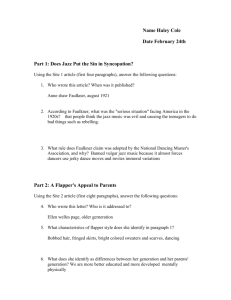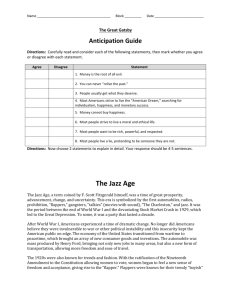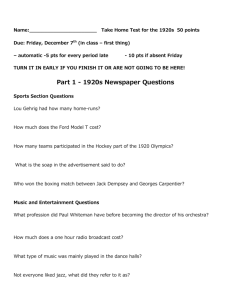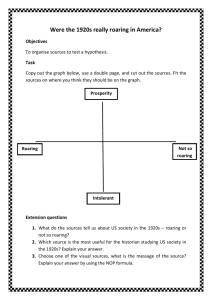The Roaring Twenties
advertisement
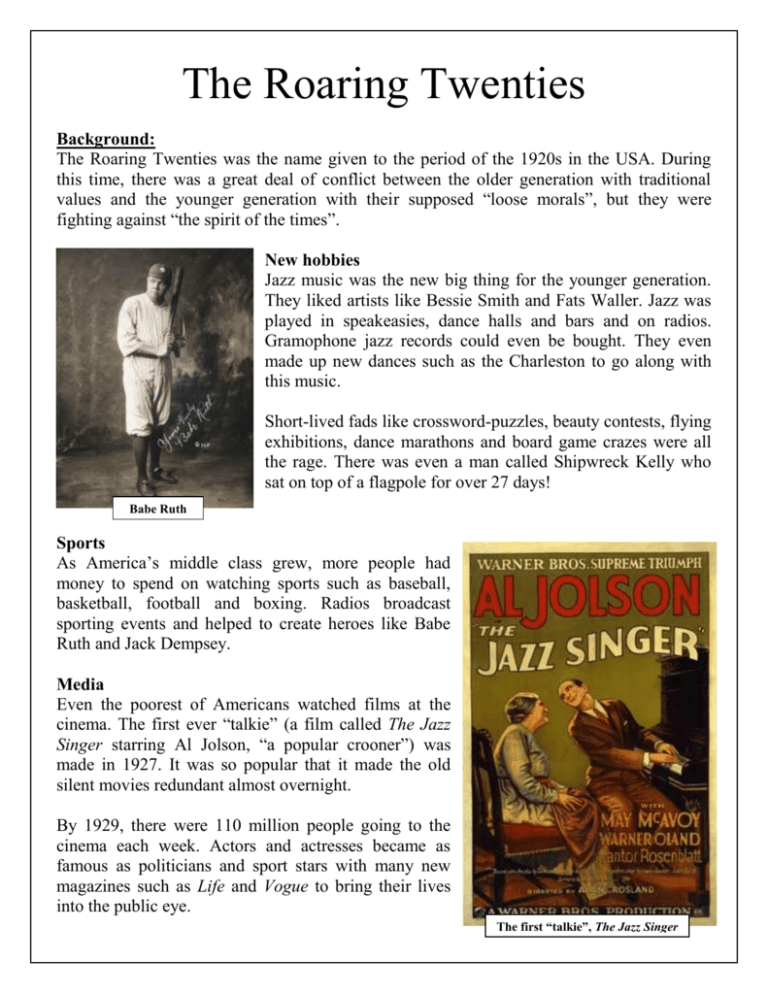
The Roaring Twenties Background: The Roaring Twenties was the name given to the period of the 1920s in the USA. During this time, there was a great deal of conflict between the older generation with traditional values and the younger generation with their supposed “loose morals”, but they were fighting against “the spirit of the times”. New hobbies Jazz music was the new big thing for the younger generation. They liked artists like Bessie Smith and Fats Waller. Jazz was played in speakeasies, dance halls and bars and on radios. Gramophone jazz records could even be bought. They even made up new dances such as the Charleston to go along with this music. Short-lived fads like crossword-puzzles, beauty contests, flying exhibitions, dance marathons and board game crazes were all the rage. There was even a man called Shipwreck Kelly who sat on top of a flagpole for over 27 days! Babe Ruth Sports As America’s middle class grew, more people had money to spend on watching sports such as baseball, basketball, football and boxing. Radios broadcast sporting events and helped to create heroes like Babe Ruth and Jack Dempsey. Media Even the poorest of Americans watched films at the cinema. The first ever “talkie” (a film called The Jazz Singer starring Al Jolson, “a popular crooner”) was made in 1927. It was so popular that it made the old silent movies redundant almost overnight. By 1929, there were 110 million people going to the cinema each week. Actors and actresses became as famous as politicians and sport stars with many new magazines such as Life and Vogue to bring their lives into the public eye. The first “talkie”, The Jazz Singer Flappers and freedom Flappers were young women who took full advantage of the new-found freedom that the 1920s offered. They smoked, drank alcohol, wore perfume and make-up, danced new dances, listened to jazz music, wore scanty bathing costumes and went on all-night drives with their boyfriends. The older generation tried to combat this behaviour with organisations such as the Anti-Flirt League and fines, but they were battling against the spirit of the times. Even getting arrested for wearing “inappropriate” bathing costumes could not dampen the flappers’ enthusiasm. A flapper Votes for women In the early 1900s, the International Women’s Suffrage Alliance campaigned for votes. In 1912, the Congressional Union (later called the National Women’s Party) was constructed and called for an additional Amendment to the American Constitution that would give American women the right to vote. By 1919, women could vote in 29 states. In 1920 women won the right to vote. Who suffered? The farmers did not share in the economic boom due to US tariffs, competition from the extremely efficient Canadian wheat farmers, a declining population growth and an enormous scale of overproduction. In 1921 a quota system was set up, therefore limiting in the number of immigrants that the US government allowed to enter the country. This quota was reduced twice by 1927, finally reaching only 150 000 immigrants per year. Many black Americans still faced brutal racism and discrimination, especially in the Southern states were lynching (hanging without a trial) was common. They were often unable to find jobs or get a proper education. The few that did find jobs worked in the farming industry as common labourers, but this field of work was greatly damaged by the trouble in the farms. The poor earned around $18 (in male) or $9 (if female) per week if they were lucky (at the time, $48 per week was considered the minimal for a decent living). They could no afford a car or any fancy, new-fangled household appliances like the middle class could. The unemployed battled to find work. They were joined by the immigrants, redundant farmers and black Americans who added to the vicious cycle of poverty that was commonly found in poor areas of American cities such as the Bronx in New York. Questions: 1. Give two reasons why you think the older generation of Americans would not have liked jazz music. [2] 2. What were some “short-lived fads” of the 1920s? [1] 3. What was the first “talkie”, who starred in it and when was it released? [1] 4. Who were the flappers? Did they get along with the older generation? [1] 5. Which two organisations campaigned for votes for women? [1] 6. Why did the farmers not share in the boom? [1] 7. Why did the black Americans not share in the boom? [2] 8. Why did the poor not share in the boom? [2] 9. What, in your mind, does “the cycle of poverty” mean? [2] 10. ‘All of the advances and benefits of the boom outweighed the plight of those who did not share in its bounty.’ Do you agree with this statement? Write a paragraph backing up your view. [7] Total points: [20]


